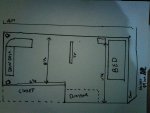What is the 10th harmonic of each division, like what does it mean
First let me add some commentary on what each of the modes are
Axial modes are the ones along the center lines of each room dimension and are your basic room resonances
Tangential Modes are the ones where any two walls or a wall and the floor/ceiling meet - these can create problems that interact with your main resonances
Oblique mode is the one where two walls and either the floor or the ceiling meet, i.e. a corner, this can also interact with the other two modes of resonance
Now, to your question
Just as in a musical tone, any room resonance can have harmonics, whole number multiples of the initial resonance frequency.
So, taking each of the modes and creating a harmonic series up to the 10th harmonic shows the following profile
| Harmonic | H | W | L | HW | HL | WL | HWL |
| 1 | 76.18 | 49.13 | 35.31 | 90.65 | 83.97 | 60.50 | 97.28 |
| 2 | 152.36 | 98.26 | 70.62 | 181.30 | 167.94 | 121.00 | 194.56 |
| 3 | 228.54 | 147.39 | 105.93 | 271.95 | 251.91 | 181.50 | 291.84 |
| 4 | 304.72 | 196.52 | 141.24 | 362.60 | 335.88 | 242.00 | 389.12 |
| 5 | 380.90 | 245.65 | 176.55 | 453.25 | 419.85 | 302.50 | 486.40 |
| 6 | 457.08 | 294.78 | 211.86 | 543.90 | 503.82 | 363.00 | 583.68 |
| 7 | 533.26 | 343.91 | 247.17 | 634.55 | 587.79 | 423.50 | 680.96 |
| 8 | 609.44 | 393.04 | 282.48 | 725.20 | 671.76 | 484.00 | 778.24 |
| 9 | 685.62 | 442.17 | 317.79 | 815.85 | 755.73 | 544.50 | 875.52 |
| 10 | 761.80 | 491.30 | 353.10 | 906.50 | 839.70 | 605.00 | 972.80 |
I then rearranged the sequence of harmonics so that it was an ascending set
35.31, 49.13, 60.50, 70.62, 76.18, 83.97, 90.65,
97.28, 98.26, 105.93, 121.00, 141.24, 147.39, 152.36, 167.94, 176.55,
181.30, 181.50,
194.56, 196.52, 211.86, 228.54, 242.00,
245.65, 247.17, 251.91, 271.95, 282.48,
291.84, 294.78,
302.50, 304.72, 317.79, 335.88, 343.91, 353.10,
362.60, 363.00, 380.90, 389.12, 393.04, 419.85, 423.50, 442.17, 453.25, 457.08,
484.00, 486.40, 491.30, 503.82, 533.26,
543.90, 544.50, 583.68, 587.79, 605.00, 609.44, 634.55, 671.76, 680.96, 685.62, 725.20, 755.73, 761.80, 778.24, 815.85, 839.70, 875.52, 906.50, 972.80
if we add identifying information the sequence becomes clearer and we can begin to see how each range interacts with the others
35.31 L 1, 49.13 W 1, 60.50 WL 1, 70.62 L 2, 76.18 H 1, 83.97 HL 1, 90.65 HW 1,
97.28 HWL 1, 98.26 W 2, 105.93 L 3, 121.00 WL 2, 141.24 L 4, 147.39 W 3, 152.36 H 2, 167.94 HL 2, 176.55 L 5,
181.30 HW 2, 181.50 WL 3,
194.56 HWL 2, 196.52 W 4, 211.86 L 6, 228.54 H 3, 242.00 WL 4,
245.65 W 5, 247.17 L 7, 251.91 HL 3, 271.95 HW 3, 282.48 L 8,
291.84 HWL 3, 294.78 W 6,
302.50 WL 5, 304.72 H 4, 317.79 L 9, 335.88 HL 4, 343.91 W 7, 353.10 L 10,
362.60 HW 4, 363.00 WL 6, 380.90 H 5, 389.12 HWL 4, 393.04 W 8, 419.85 HL 5, 423.50 WL 7, 442.17 W 9, 453.25 HW 5, 457.08 H 6,
484.00 WL 8, 486.40 HWL 5, 491.30 W 10, 503.82 HL 6, 533.26 H 7,
543.90 HW 6, 544.50 WL 9, 583.68 HWL 6, 587.79 HL 7, 605.00 WL 10, 609.44 H 8, 634.55 HW 7, 671.76 HL 8, 680.96 HWL 7, 685.62 H 9, 725.20 HW 8, 755.73 HL 9, 761.80 H 10, 778.24 HWL 8, 815.85 HW 9, 839.70 HL 10, 875.52 HWL 9, 906.50 HW 10, 972.80 HWL 10

